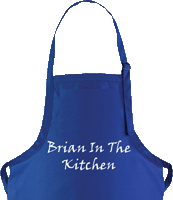Brian in the Kitchen Recipes


BRIAN IN THE KITCHEN brought to you by Stittsworth Meats
September 16 2009
Technique Week - How To Cook Pasta
If you will be serving pasta as a main course with, say, a salad and some crusty bread, count on 4 ounces of pasta per diner. In other words, a one-pound box of dried pasta will serve four as a main course. If the pasta will be a side dish to a protein (think chicken Parmigiana), allow only 2 ounces per diner.
To cook one pound of dried pasta, first bring one gallon of water to a rolling boil. Once the water is boiling, add enough salt so that the water tastes like sea water. Don't add the salt until the water is boiling, or the salt could pit your pot.
Add the pasta all at once, bending long pasta into the water and around the inside of the pot as the boiling water starts to soften the pasta. Don't break the pasta to fit the pot.
Once the water has come back up to a boil, turn the heat down a bit to prevent the pasta from boiling over. Boil the pasta until it is al dente...just slightly firm in the center. Al dente translates to "to the tooth" or "to the bite," and it means that the pasta should still provide some resistance instead of being completely soft all the way through.
Should I Add Oil to the Water?
Do not add oil to the water. As long as you are using at least 1 gallon of water per pound of dried pasta and your pot is large...the level of the water is at least 2 inches below the top of the pot, your pasta should not boil over. Adding oil to the water does nothing but coat the noodles with fat and keep them from absorbing sauce later on.
When is It Done?
Pasta boxes generally give you cooking times, but I have never found them to be accurate. Most directions will tell you to cook spaghetti between ten and twelve minutes. For my taste, it only takes about 8 minutes. So, use the directions on the box as a guide, but do check on the pasta a few minutes before. Reach into the pot with a long handled fork or pasta server and pull out one strand of pasta. Let it cool for a moment, and then taste it. When the pasta is done to your liking, it is time to drain it. I reserve about 1/2 cup of the cooking liquid and use it to finish the pasta with the sauce.
How to Finish Pasta
Thoroughly drain the pasta in a colander, and then return the pasta to the pot. Add about 2 cups of your sauce and the reserved pasta water. Cook and stir over high heat until the sauce has reduced to its original thickness. Then, depending on your recipe, add either a splash of heavy cream, or a tablespoon or so of olive oil or softened butter and stir this into the sauce.
Your pasta will end up coated with a very silky sauce. Why does this happen? Stirring the fat and starch water into your sauce and pasta creates an emulsion of fat in water, which will give you a creamy mouth feel, like a well whisked vinaigrette. The starch in the cooking water further thickens the sauce and contributes to its ability to coat the pasta. To really gild the lily, stir in some freshly grated parmesan cheese at the end of cooking. Serve individual portions of coated pasta, and then top with some extra sauce.
To Rinse or Not to Rinse
Unless you are planning to serve the pasta cold, as for pasta salad, do not rinse it. If you are concerned about the pasta sticking together and you are not going to serve it immediately, just stir in a cup or so of sauce. This will keep the pasta nice and moist and keep the starches from gluing your noodles together.
How to Cook Fresh Pasta
Unlike dried pasta, which is most frequently made of 100% semolina, fresh pasta is made with an egg-enriched dough. As such, it is more delicate than hearty dried pasta. To cook fresh pasta, follow the procedure for cooking dried pasta, but decrease the cooking time to 2-3 minutes, and always taste to make sure the pasta has the texture you want.
Finish fresh pasta in the pot, just as you would dried pasta, but be gentle in stirring since the pasta is more delicate.
How to Cook Frozen Stuffed Pasta
To cook frozen ravioli or tortellini, follow the instructions for cooking dried pasta. Once you add the frozen pasta to the boiling water, it will take a minute or two for the water to come back up to a boil. Once the water has returned to a boil, adjust the heat to maintain a gentle boil. Once the pasta floats, it is ready to be drained.